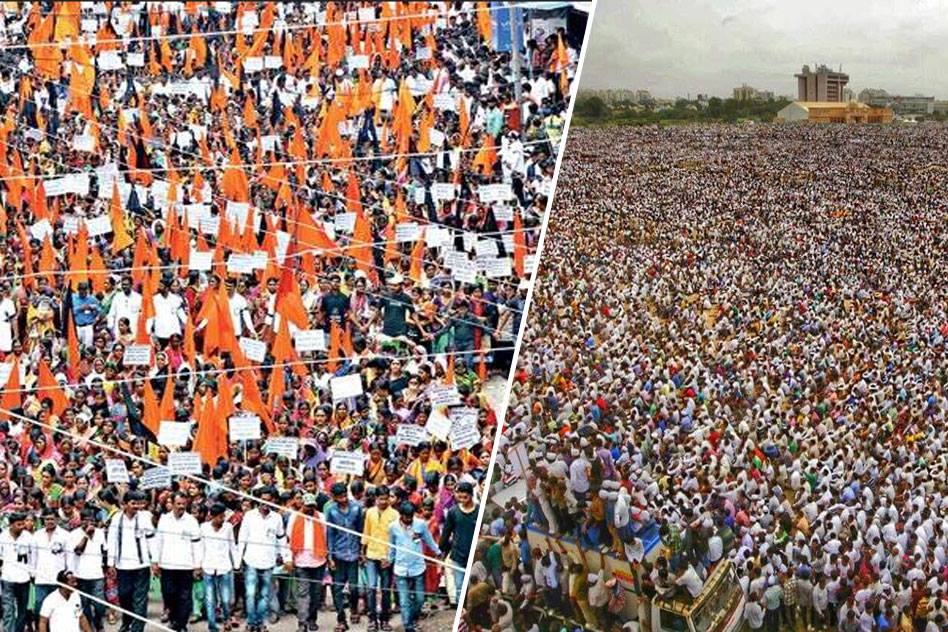
Lakhs Of Marathas Join Silent Protest In Maharashtra Demanding Reservation: All You Need To Know About It
26 Sep 2016 9:26 AM GMT
[Update: This article was amended at 10:00 pm, Monday 26 September 2016, after our community members pointed out a factual error. Previously it was mentioned that there were 2 Lakh people who participated in the protest which has been corrected to more than 20 Lakh people participating in Pune alone]
Maharashtra has always been embroiled by some political movements and protest marches. The Dalits had poured into streets to voice their disapproval in 1989 after the state government had censored B.R. Ambedkar’s “Riddles of Ram and Krishna”. Muslim community had erupted in demands of banning Salman Rushdie’s “Satanic Verses”. Earlier in July, Mumbai also witnessed a huge gathering protesting against the demolition of Dr B R Ambedkar’s office in Dadar.
The state is now witnessing another huge protest over the past two months, this time by the Marathas. The silent protest reached its tipping point with the participation of over twenty lakh people in Pune alone. Leading the march were school and college girls, followed by other women protesters. Doctors, advocates and people in varied professions also took part. It is undoubtedly the biggest protest ever seen in the recent history of the state. The protest has become a major concern of the political leaders and the government.
Shops were closed on closed on Sunday, and major traffic diversions were made in Pune for 5 kilometres as people marched with saffron flags bearing images of Shivaji.
What is the protest about?
The Marathas, who comprise a majority of 32 percent of the state’s population, have been resenting the Scheduled Caste and Tribes (Prevention of Atrocities) Act 1989 formulated to protect discrimination against SCs and STs. They believe that the law gives a little too much favour to the Dalits.
This time the protest which was triggered by the brutal rape and murder of a girl from the community two months ago, allegedly by three Dalit men in Kopardi village, Ahmadnagar, is now demanding 16 percent reservation for Marathas in the employment and education sectors, amendments to the Prevention of Atrocities Act and punishment for the rape accused.
According to The Hindu, The Pune Protestors also highlighted the plight of farmers and lack of job opportunities for the Maratha youth.
“In many instances, we find that students with no merit get ahead taking advantage of reservation while we lag behind despite working hard,” said Shobha Mhaske, a student, before the start of the rally.
Two parallel Maratha rallies held at Yavatmal and Washim districts — both farmer suicide belts — focused on farmers’ issues. The protests are being guided by hardline Maratha organisations like Maratha Seva Sangh, but they are trying to keep the protest apolitical and even leaderless.
The history of Marathas
Marathas have had a major stronghold in the state. While most of the chief ministers of the state have been Marathas, the agrarian sector of the state also comprises mainly Marathas. A majority of this agrarian sector has been living under grim economic situation since the time the liberalisation got intensified.
While influential Marathas got political power and entered cooperative sectors, the farmers became the deprived community. Economic woes became to be an ever-increasing concern for them. Today, the majority of farmers who commit suicides in Maharashtra are Marathas.
While the OBCs and other deprived communities have reservations in the state, Marathas remain helpless.
Reservation for Marathas
Marathas are demanding for the reservation since the 1980s, but it got a major boost in 2008 after the chief minister Vilasrao Deshmukh and NCP chief Sharad Pawar lent ears to their demand. However, the demand was rejected by the Backward Class Commission after a thorough examination.
Marathas had earlier demanded reservation along with the OBC block, but OBC leaders always objected it.
Before the 2014 Lok Sabha polls, the Congress and NCP had put forward the same demand to a committee chaired by senior Congress leader Narayan Rane. It found that 16 percent reservation was favourable for the Marathas, but High Court didn’t rule in favour of the Marathas as they found that the community was not backward. The court also ruled that such a reservation would take over all reservations in the state — over 50 percent — which went against the apex court ruling.
The Devendra Fadnavis-led BJP government in the state also supported the reservation, and now a committee under education minister Vinod Tawde has been set up to look at the matter.
“Nothing has been done to mitigate the travails of farmers, with successive governments failing to check the wave of farmer suicides. All the compensation and subsidies have only benefited the rich. It is the duty of all elected representatives of the Maratha community to participate in these marches,” Mr. Bhosale said to The Hindu.
A big question
If the Marathas now opt for 16 per cent of reservation in the state, it would require a constitutional amendment which is a time-consuming and pretty complicated affair. Since Marathas have always enjoyed hierarchical benefits, it won’t be possible to term them “backward”.
The case is very similar to that of the agitation by the Jats in Haryana and Patels in Gujarat. However, this protest has not resulted in any violence.
The Dalits in the state have, however, decided not to retaliate against the protesting Marathas.
The Maharashtra government is now in a complicated position.
 All section
All section













